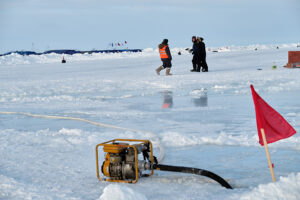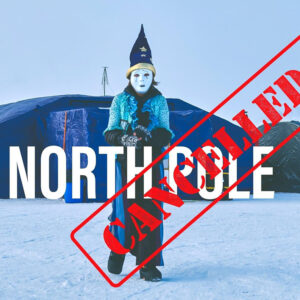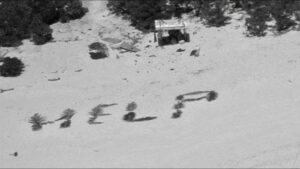Ramón Larramendi and team, with a 2000 kg windsled, closing in on Summit Camp after challenging temperatures, meltwater, heavy, soft snow, and 3 storms
Ramón Larramendi, leader, Ignacio Oficialdegui, Vicente Garcia Leal, Hilo Moreno, Karin Moe Bojsen and Nacho Garcia, began their expedition on the Greenland Ice Cap on May 19th when a helicopter dropped them at 1400 meter above sea level (masl). They immediately started to assemble the windsled, a task that took 7 hours. The sled weighed 2000 kg.
“Our intention was to spend twenty hours underway, with two navigation teams that will rotate in the control of the kites, one team led by Ramon and another one by Ignacio Oficialdegui, an experienced Windsled pilot. The Danish Karin also knows how to handle it well. And the rest of the team will have to learn on these first days,” reported the team on May 23rd.
Challenging Start
Ramon reported an unusual amount of meltwater at the start, compared to the same location during an expedition in 1986. He said, back then the melt was two months later. At 1700 masl they sailed across a frozen lake, which is reportedly unusual fir this elevation.
The heavy, soft slowed them down, “it was impossible to move the 2,000 kilos convoy with kites, so we divide the four modules in two vehicles. It is another advantage of the WindSled: its versatility. And of course, this division took us some time, as it had to restructure all equipment (food, kites, communications …) into two parts with three expeditionary each.”
The two windsleds, with Ramon and Ignacio as pilots, meant to stay together till they reach 2000 masl, but they soon lost sight of each other. Eventually, they decided to set a waypoint and meet there. Ramon’s sled had a bigger kite and reached the waypoint first. They home team reported, “Driven by a strong wind of 50 km/h, they had traveled 156 kilometers in just 10 hours. And it was done non-stop, with a 30 square meter kite whose shot had to be on one side, at 75 ° angle, to maximize the wind eolic energy.”
Snow storms
On May 30 the team reported a blizzard with winds of about 100 km/h. The big kite blew away. When the winds calmed down, at 3 am, Ramon and Karin went out and found it about 100 meters away, buried in the snow, with the controls and 300 m of lines. “Losing it would be a tremendous problem.” The sled was “completely buried” after the storm. After this storm, they covered 250 km to reach 2,030 meters altitude.
On June 2nd, the team reported another “unexpected” wind and snow storm, which grounded them for 3 days.
“The weather goes crazy. With temperatures of 15°C sunshine by day, to -28°C at night, 43°C of difference. And with a wind that is not good for our direction.”
In these conditions, they decided to split the sled again in two teams and managed to travel at 15km/h. But not for long. Another storm hit them. The two sleds lost sight of each other. The big kite blew away, again. Ramon and Nacho went out on foot and found it, with luck, 2950 meters from the sled. Ramon said they were still dressed in their navigation clothes, which was way to warm for walking. “We sweat a lot and there was a risk of becoming dehydrated.” Temperature was -15ºC with a cold wind.
Ignacio’s team also had to stop, to repair a ripped kite.
Closing in on Summit Camp
Yesterday Ramon reported from 3150 masl and said they have covered 700 km since the start. They expect to arrive at the Science Station at Summit Camp today.
Ramon is satisfied with their science work, “despite these difficulties, we were able to collect data on snow and radiation from cosmic rays, which are our scientific objective. We have had many holes in the surface, and the muon detector.”
As for the expedition so far, “We have done fifteen stages, but the accumulated fatigue cannot dampen our spirits, accompanied by the beauty around us. Those sunsets and sunrises in which, by an effect of light called parhelion, we saw three suns on the horizon, and often more than a rainbow at the same time. We sailed at 20 km/h on this endless plain with the continuous feeling that we are on another planet.”
The expedition, in which nine people participate, is on a 2,000 kilometers journey that starting from the southwest coast, near Kangerlussuaq (Lat: N 67º 009‘ Long: W -50º 43’) heading towards the highest point of the interior ice desert (Inlandis) where the scientific USA Summit Camp base is located. From there they will go down towards the southeast coast, to Isortoq, where part of the team will leave to be replaced by new members reported their website. From Isortoq the team return across the Ice Cap to Kangerlussuaq where the adventure will finish around 32 days after departure. They will collect samples for different scientific projects during the journey.
The new prototype of WindSled has been experimented with, with significant improvements compared to the one used in the 2014 Greenland Circumnavigation.
Previous/Related
Greenland 2016: Teams on the Ice Cap
Windsled sites:
https://greenland.net/windsled/
https://greenland.net/windsled/greenland-ice-summit-expedition-2016/
https://www.facebook.com/ramonlarramendi/
https://greenland.net/windsled/expedition-step-by-step/
https://www.tierraspolares.es/trineodeviento/bitacora-de-viaje/ (Spanish)
#Greenland #windsled






